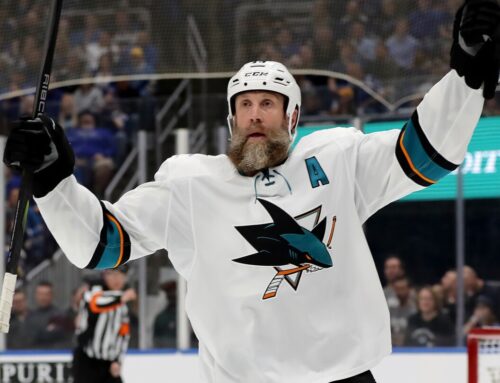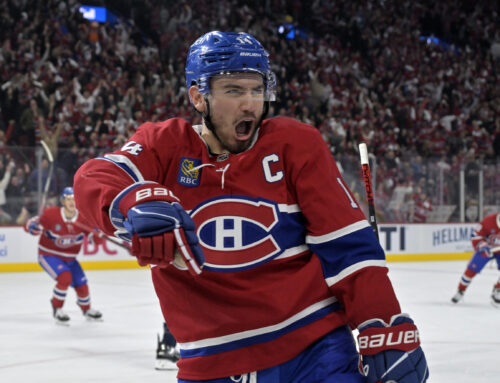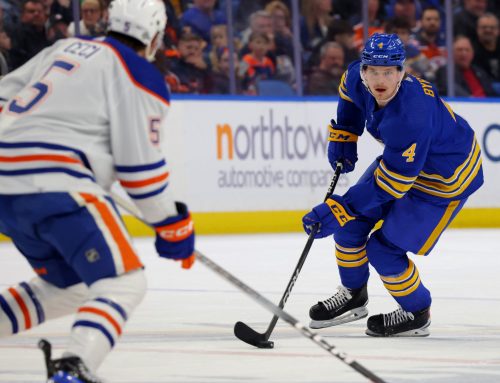
It appears Sean Monahan’s recovery from multiple surgeries is going as planned, according to NHL.com. It’s nice to hear there haven’t been any setbacks for the Calgary centre and that he should be ready to go when the team hits the ice for training camp in a few months.
In general, I’m wary of drafting players coming off significant offseason surgery. If Monahan is all ready to go for the start of training camp, though, I’m not sure how much we should be concerned as fantasy owners. The concern would be if we get close to training camp and the team says he’ll need another couple weeks. Until then, it seems there’s nothing to worry about.
*
In Monday’s Ramblings, we discussed forwards who saw significant power play ice time changes. As noted in those Ramblings, some ice time changes are obvious. Second-year players who only got a brief stint in 2016-17 like Mathew Barzal come to mind. Sometimes, though, changes come because a player has earned them (or maybe the coach just lacks options).
These Ramblings will look at increases and decreases in ice time for a given defenceman from the 2016-17 season to the 2017-18 season. Let’s start with the top-20 blue liners seeing more PP TOI (as always, data from Natural Stat Trick):

A few words on some of these players and situations.
Vegas
Not surprisingly, there are a lot of defencemen from Vegas on this list. Brad Hunt was usually in the AHL, Nate Schmidt was behind guys like John Carlson, Dmitry Orlov, and Matt Niskanen, and Colin Miller wasn’t far off from Hunt’s situation. Shea Theodore isn’t very far down the list, either, coming just inside the top-40.
Here’s the double-edged sword: it’s great these guys are getting their time to shine and, for the most part, taking advantage of it with very productive play. On the downside, they’re all getting the opportunity; four defencemen saw at least 100 PP minutes for Vegas, and the spread was only 47 seconds per game between the four of them.
One thing I will say is that Theodore wasn’t really a regular for Vegas until the middle of November. Remember, he was left in the AHL to start the year because the team had a glut of blue liners they couldn’t send down without exposing them to waivers. When he did join the roster, he was scratched a couple times before settling in for good on November 16th. From that point on, Theodore led all Vegas blue liners in PP TOI, PP TOI per game, and was playing 1:10 more per contest than Schmidt. If I were to guess on who leads them again next year, it’s the former Anaheim Duck, with Miller the next option.
Unless, of course, they bring in Erik Karlsson…
Even with the jump in PP minutes, it’s hard to see Heed having much fantasy value unless his coaches start trusting him. He was consistently a healthy scratch down the stretch for the Sharks and ended up only playing a little less than a third of the season for the team. He was a tweener for them; not really an NHL regular but too good for the AHL (he has 61 points in 65 career AHL games).
Heed is under contract for 2018-19, so he’ll have another year to prove himself. It seems unlikely the Sharks move Heed’s role from inconsistently in the lineup to 20 minutes a game in his age-28 season. Whether by adjusted shot share, actual goal share, or expected goal share, he was at or near the top in every regard for San Jose. We can quibble about his usage or sheltering but he crushed the opportunity given to him. It’s just a matter of whether it will lead to a bigger role.
The Leafs finally took the handcuffs off Rielly and his power play usage and it paid off in spades. He led all defencemen in points per 60 minutes on the PP and it wasn’t even close; his 8.96 points/60 was 1.85 points/60 ahead of second-place Tyson Barrie (7.11). The gap between Barrie and 19th-place Jake Gardiner (1.80) was smaller than the gap between Rielly and Barrie. Keep in mind, this is one season after Rielly played under a minute a game on the PP.
His on-ice shooting percentage on the PP (the rate the team scores with him on the ice) was high, but not as high as league leaders like Dustin Byfuglien and Kris Letang. Also, there is enough talent to support such a conversion rate.
Here’s the problem: Rielly played the vast majority of his minutes (around 80 percent) with James van Riemsdyk and Tyler Bozak. It’s not certain whether both, or either, will be back with the team given they’re unrestricted free agents. Can Rielly re-create that level of production with, say, Andreas Johnsson and Kasperi Kapanen? Does he instead get moved to the Auston Matthews PP unit with the Leafs converting to a top-heavy PP TOI structure like the Penguins, Sharks, and Caps?
The answers to those questions will go a long way in determining Rielly’s fantasy value next year and I’m not sure we’ll get those answers until late in training camp or even into the season.
The young Lightning defenceman was the topic of discussion in a recent Ramblings and most anything that applies there is applicable here. Victor Hedman will still see the lion’s share of prime PP minutes but Sergachev proved more than capable of serving as a number-2 for now.
This is a curious one for one specific reason: the Coyotes didn’t really have one specific PP setup all year. Sometimes, Oliver Ekman-Larsson was used by himself on the top unit, sometimes he was joined by Jason Demers, Alex Goligoski, or Jakob Chychrun. Here’s how it broke down (minutes rounded up or down accordingly):
- OEL played 252 minutes on the power play in total.
- OEL skated 19 out of 252 minutes with Goligoski (7.5 percent).
- OEL skated 29 out of 252 minutes with Demers (11.5 percent).
- OEL skated 65 out of 252 minutes with Chychrun (25.8 percent).
- OEL skated roughly another six minutes or so with other various defencemen (2.4 percent).
Out of his 252 minutes, OEL skated nearly 45 percent of his time with one of Goligoski, Demers, or Chychrun, a handful of minutes with some others, and about half his PP time by himself on the blue line.
It reminds me of Columbus. Arizona could never really get their power play going so they were trying anything and everything to get some goals.
Unfortunately, it doesn’t really clarify Chychrun’s role for next year. He’s clearly a talented defenceman and a mix of a less-than-stellar roster combined with injuries haven’t really put his full talents on display yet. Were he to be paired with OEL on the top PP unit, it would be good news for his fantasy value. If he were to be relegated to the second unit behind a heavily-used OEL unit, well, we might have to wait another year or two for him to start scraping his fantasy potential. It seems likely the team would turn to him to be OEL’s running mate if they were to run a 3F-2D top PP unit, it’s just a matter of if, or how often, they use it.
To the other end of the spectrum, we need to look at defencemen who lost their PP TOI. These are the 20 biggest decreases in power play ice time for blue liners from 2016-17 to 2017-18:

Let’s get to it.
Like teammate Brandon Sutter, Stecher’s PP TOI all but disappeared. He went from 2:42 per game in 2016-17 (nearly 193 minutes total) to… 15 seconds per game (17:22 total). We saw Alex Edler’s name in the increase column and that meant someone had to lose their minutes and that guy was Stecher. And he lost almost all of them.
It’s not really a huge surprise. Out of 50 defencemen with 150+ power play minutes in 2016-17, Stecher was 49th in points per 60 minutes. The team scored 5.29 goals per 60 minutes on the power play with him on the ice, 48th out of those 50 defencemen. With Edler patrolling the blue line on the PP, that goals/60 rate increase to 8.98 in 2017-18. Sure, there are mitigating circumstances (Brock Boeser) but that same mitigating circumstance means that Stecher isn’t likely to reclaim that PP time in 2018-19.
There still isn’t much depth on the Canucks roster as far as scoring is concerned so without those power play minutes, Stecher might not carry much fantasy value next year. Edler is a UFA after the season, though, so Stecher dynasty owners may need to exercise patience.
In a situation mirroring that of Stecher and Edler, for Rielly to gain all his PP minutes it likely meant someone had to lose theirs. Someone did, and it was Zaitsev.
Zaitsev didn’t really fall out of favour with the Leafs overall. In fact, his five-on-five ice time went up from 2016-17. It was just time for Rielly to assume primary PP duties and that’s exactly what happened. As mentioned in the section on Rielly, there’s some changes coming to the PP if only because of a loss in personnel. Maybe Zaitsev can be used as part of a 3F-2D unit with Gardiner? It’s doubtful but possible.
Without the power play time, Zaitsev isn’t gifted enough offensively to create at five-on-five. He can be ignored in all leagues (save deep ones) where hits and blocked shots aren’t counted.
Though his offensive flair has never been the focal point of his skillset, when he’s been given PP minutes, McDonagh has been able to put up 40-point seasons. Unfortunately, the acquisition of Kevin Shattenkirk made it unlikely he’d get top minutes. Then McDonagh was traded to a team with Victor Hedman and Mikhail Sergachev.
This isn’t to say McDonagh can’t be productive. He has 30-point seasons with healthy blocked shot totals that will play in leagues with that category. Tampa Bay should also be a high-scoring team again which could mitigate some PP points lost. But for those with McDonagh in leagues that count PPPs as their own category, barring injury, those points will be few and far between.
Daley was mentioned in passing in the forward section that covered Frans Nielsen’s PP TOI decline.
With guys like Henrik Zetterberg (he’s still a good playmaker), Anthony Mantha, and Dylan Larkin, there is more than enough talent for a successful top PP unit. It’s a matter of who gets to run it. Mike Green and Niklas Kronwall played 2:20 and 2:19 each on the power play; Daley was the next-highest per game at 36 seconds. With Green gone, does Daley just slide into that role, and if so, which unit will it be with? If the team stacks the top power play and Daley is running it, he can have a productive and relevant fantasy season. If it’s Kronwall, then Daley is waiver wire fodder. If they split up the talent, it may not be enough.
Or maybe they just bring in someone else to do it. Take a wait-and-see approach with Daley.





 UTA
UTA PHI
PHI VGK
VGK EDM
EDM
 VAN
VAN L.A
L.A ANA
ANA NYI
NYI
